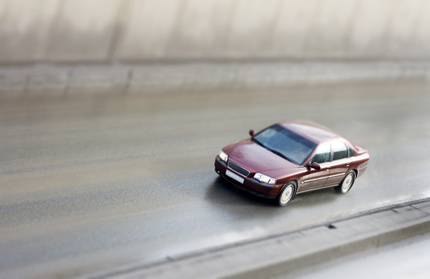
Anyone learning to drive should use a car equipped with an automatic transmission, because shifting gears and gaining clutch coordination on a manual transmission car takes a lot of practice. There are far too many other skills to concentrate on for the sake of becoming a safe driver. Safety is the first consideration for you, your passengers and all other occupants of the road.
Check the vehicle. Look over the tires, glass, wipers and lights before getting in. Tires should be properly inflated with enough tread to touch Lincoln’s head with an inverted penny in the groove. Glass should be free of cracks and wipers able to clear rain or snow from the windshield. Check the lights in front and back as well as both turn signals. Ask someone to step on the brake pedal while you check the brake lights in the rear.
Get in and buckle up. Pull the seat belt and shoulder strap over yourself and snap it securely into the buckle. Seat belts save lives. It only takes a few seconds to put one on and it’s not the least bit uncomfortable. Be sure all passengers are buckled and follow safety regulations regarding children’s weight and proper restraining devices.
Check mirrors. Clean and adjust the rear view and side mirrors. Set the rear view mirror to let you see straight out the back window. Side mirrors should show the back corners of the car to give you a location reference to other objects.
Start it up. Turn the key to start the engine, apply the brake and shift into the desired gear with the gear lever on the steering column or floor console between the front seats. Depress the accelerator lightly to get the car rolling. Now check the brakes before you actually need them to stop the car.
Choose the gear. Shift the car into the best gear for the road and weather conditions. Obviously, if you want to back up, reverse is the only choice ("R"). For normal driving, shift into high gear and leave it there. A circled "D" allows best fuel efficiency at high speeds. On vehicles with overdrive, that’s high gear. To move forward on loose gravel or a muddy dirt road, use one of the lower gears ("L1" or "L2"). Shift into a low gear any time you are going down a steep grade. Stay in high gear going uphill and the automatic transmission will adjust itself to meet the demand.
Use the right foot. Use the same foot for the accelerator and the brake. Reflexes will take your foot from gas to brake in less than half a second. Two-footed driving needlessly burns fuel and brake pads.
Take a hands-on approach. Grab the steering wheel with both hands at clock positions of 10 and 2, or 9 and 3 if the wheel holds an air bag. Make turns by crossing one hand over another, with one hand on the wheel at all times.
Look around. Check for pedestrians, bicyclists, joggers and children before pulling away from the curb or out of a driveway. Look ahead for hazards or upcoming steering adjustments. Check both ways before entering intersections. Be aware of all other vehicles around you, including the ones behind you. Check mirrors and turn your head quickly to check spots the mirrors don’t show before changing lanes or entering traffic.
Use the turn signal to show other drivers your intention to change lanes, make a turn, enter the roadway or parallel park.
Take to the highway. Enter a highway by gaining speed as you drive up the on ramp. Signal your intention to merge with traffic and check mirrors and blind spots for a safe gap in traffic. Drive in the center lane on three-lane roads. Use the right lane on two-lane highways, saving the left lane for passing. Although it may be tempting to speed on highways, keep your speed within 5 mph of the posted speed limit.
Drive according to location and conditions. Use a gentle touch on the brake and accelerator in snow and ice. Beware of hydroplaning in rain, and dry the brakes by holding the pedal down a little while moving. Constantly watch for pedestrians in the city. Look out for children and pets in suburbs, and watch for wildlife on rural routes.